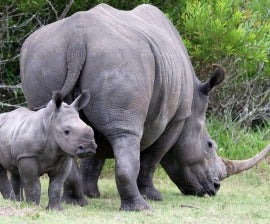-

A rhino and calf grazing peacefully. Duncan Noakes/istock
Although habitat loss is an important consideration when evaluating the decline in rhino populations, the main threat comes from poaching.
Rhino horn is a highly valuable commodity, used in Traditional Chinese Medicine in China, Vietnam and other parts of East Asia.
Recent years have been disastrous for rhino conservation, with the number of rhinos poached adding up to 200-300 or more per year in South Africa alone; this is 30 times the poaching levels seen in the 1990s. And the poaching shows no signs of abating.
Rhinos face an uncertain future
Populations of rhinos in other countries are also being severely affected by poaching.
Asian rhinos are at enormous risk from this problem. The Javan and Sumatran rhinos of Southeast Asia are already on the brink of extinction. Around 300 Sumatran rhinos live in Indonesia and Malaysia, and a population of around 50 Javan rhinos clings on in Indonesia.
Fewer than 3,000 greater one-horned rhinos remain in Nepal and northeastern India. Reports from India suggest that beleaguered populations of one-horned rhinos in Assam are being poached, with horns smuggled across the poorly protected border with Myanmar. Since 2008, there have been more than 60 known rhino poaching incidents in India and Nepal.
In Africa, Kenya’s black rhinos have been reduced in number from around 20,000 animals in the 1970s to approximately 500 today. Zimbabwe’s populations of white and black rhinos are being heavily targeted. Swaziland officials have expressed concern that poaching could threaten the future of rhinos in their tiny country.
South Africa is home to 70 percent of the world’s remaining rhinos, thanks mainly to the successful repopulation of southern white rhinos from a few individuals at the turn of the 20th century that has grown to some 20,000 animals today.
The far less numerous black rhinos number no more than 5,000 animals, with the biggest populations located in Namibia, South Africa, Kenya and Zimbabwe.
Legal protection
Most rhino populations have had legal protection from the impacts of international trade since the 1970s through their listing on Appendix I of the Convention on International Trade in Endangered Species (CITES).
However, the populations of white rhinos in South Africa and Swaziland were downlisted to Appendix II in 1994 and 2004 respectively, specifically to allow the export of live rhinos and hunting trophies.
Saving the rhino
If rhino populations are to be saved from extinction at the hands of poachers, several actions must be undertaken:
- The remaining rhino populations need better protection.
- More and better trained and equipped park staff are urgently required.
- Border security needs to be tightened up to stop horns from being moved between countries.
- Loopholes in national and international regulations should be closed to prevent poachers from posing as trophy hunters and exporting ”trophy” horns for sale into the lucrative traditional medicine markets.
- Exports of live rhinos from South African ranches to China, Vietnam and other Asian destinations need to be stopped.
- Horn stockpiles that are currently in private hands need to be managed by governments in a transparent way, and preferably destroyed.
In addition, and perhaps most importantly, every effort needs to be made to reduce demand for rhino horn in China, Vietnam and elsewhere in Asia, through engagement of the Traditional Chinese Medicine community, and through education, awareness-raising and rigorous law enforcement.
Innovative disincentives
Other innovative, if controversial, attempts to reduce rhino poaching have included dehorning rhinos and infusing rhino horns with poison to discourage potential users of rhino horn products.
What is HSI doing?
Humane Society International works closely with CITES authorities in rhino range and consumer states, the U.S. and other influential countries such as the European nations [PDF] including the UK, pushing the case for greater enforcement and the closing of loopholes.
We sent a letter [PDF] to the South African government urging a moratorium on rhino hunting (along with tighter legislation concerning rhino horn trade) and asked our advocates to do the same.
HSI also commissions research on the trade in rhinos and rhino horn products in Vietnam, China and elsewhere, in order to inform the relevant authorities and the public of the current status of the trade.
Ultimately, the incentive to poach rhinos will only disappear when demand is reduced and prices drop.
Otherwise, these magnificent herbivores may become a thing of the past.
